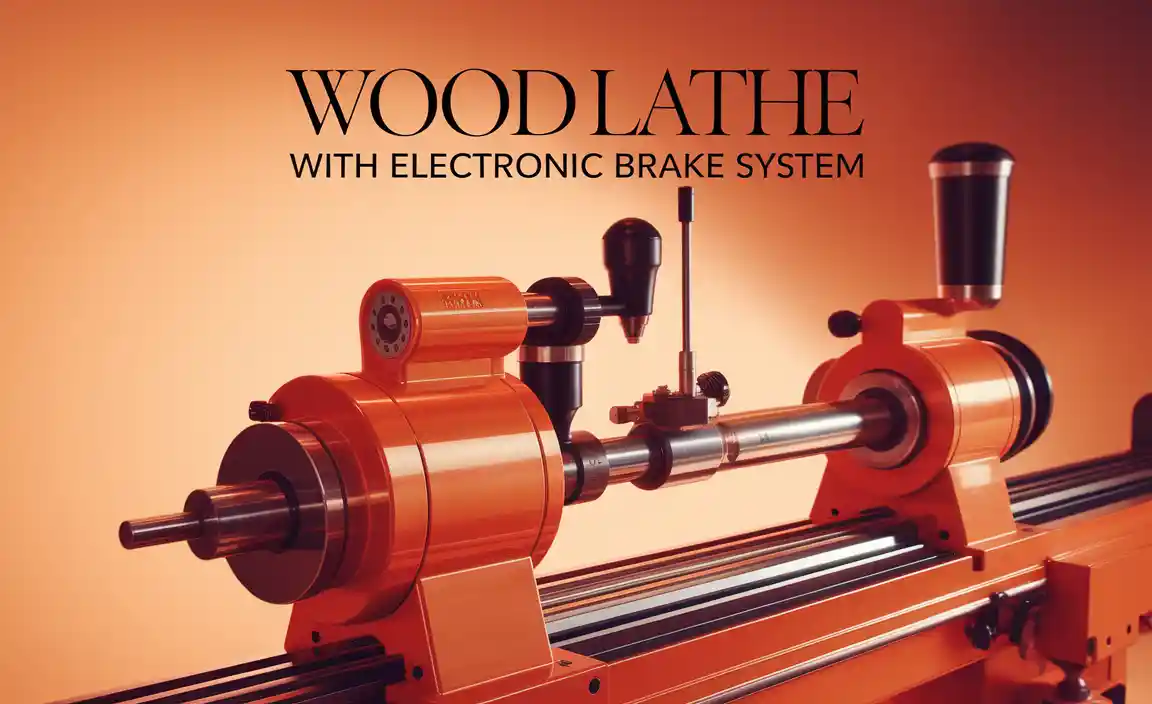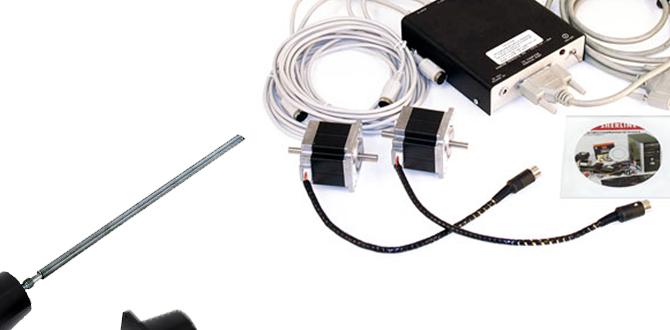Quick Summary
The TIALN 40-degree ball nose end mill is a top choice for profiling cast iron. Its advanced coating and specific geometry help it slice through tough cast iron smoothly, creating precise shapes with less effort and longer tool life.
Mastering Cast Iron Profiling with Your TIALN 40-Degree Ball Nose End Mill
Profiling cast iron on your milling machine can feel like a challenge for beginners. The material is dense and can be hard on your cutting tools. You might worry about chatter, poor surface finish, or quickly dulling your end mill. But don’t get discouraged! With the right tool and a few simple techniques, profiling cast iron can become a rewarding part of your machining journey. This guide will walk you through using a TIALN coated 40-degree ball nose end mill, showing you how it makes the job easier and more effective. Get ready to create smooth, accurate profiles with confidence!
Why the TIALN 40-Degree Ball Nose End Mill Shines for Cast Iron
When you first look at milling cast iron, you might think any sharp tool will do. However, cast iron’s unique properties mean it needs a specially designed cutting tool. This is where the TIALN 40-degree ball nose end mill shines. Let’s break down why this specific tool is an excellent choice, especially for beginners tackling cast iron profiling.
Cast iron is a popular material for many projects, from engine blocks to decorative pieces. It offers good strength and vibration dampening. However, it can be abrasive and brittle. This combination means you need a tool that can handle the toughness without wearing out too quickly, and one that minimizes the risk of chipping or breaking under moderate stress. Traditional end mills might struggle to achieve a clean cut consistently, leading to frustration.
The TIALN 40-degree ball nose end mill is engineered to overcome these difficulties. It offers a fantastic balance of durability, precision, and performance specifically for materials like cast iron.
What Makes a TIALN Coating Special?
The “TIALN” in the name refers to a specific type of PVD (Physical Vapor Deposition) coating. TIALN stands for Titanium Aluminum Nitride. This coating is a game-changer for cutting tools, especially when working with abrasive or hard materials.
- Heat Resistance: TIALN coatings are exceptionally good at resisting high temperatures. When a tool cuts metal, friction generates a lot of heat. This coating acts as a barrier, preventing the heat from transferring to the carbide or steel of the end mill itself. This keeps the cutting edge harder for longer.
- Hardness: PVD coatings are incredibly hard. This increased hardness means the cutting edge is more resistant to wear and abrasion. Cast iron, particularly older, sand-cast types, can be quite abrasive. The TIALN coating helps the tool maintain its sharp edge through these challenging materials.
- Reduced Friction: The smooth surface of the TIALN coating reduces friction between the tool and the workpiece. Less friction means less heat buildup and more efficient chip evacuation.
- Oxidation Resistance: TIALN offers excellent resistance to oxidation at high temperatures, which further contributes to the tool’s longevity.
For beginners, this means your end mill will likely last longer, requiring fewer replacements and reducing the chances of unexpected tool failure during a cut. This consistency is invaluable when learning new machining techniques.
The Role of the 40-Degree Helix Angle
The helix angle of an end mill refers to the angle of the flutes (the spiral cutting edges) relative to the axis of the tool. For general-purpose end mills, you often see helix angles around 30 degrees. However, a 40-degree helix has specific advantages for profiling cast iron:
- Improved Chip Evacuation: A steeper helix angle, like 40 degrees, can help to “screw” chips out of the cutting zone more effectively. This is crucial when profiling, especially in tighter areas, as it prevents chip recutting and buildup, which can lead to poor surface finish and tool damage.
- Smoother Cutting Action: The 40-degree helix generally results in a smoother cutting action compared to lower helix angles. This means less vibration, or chatter, which is a common problem when milling cast iron. Less chatter leads to better surface finishes and less stress on your machine and the workpiece.
- Increased Strength: While it might seem counterintuitive, a 40-degree helix can offer a good balance between cutting efficiency and flute strength, making it suitable for moderate side loading encountered during profiling.
This specific helix angle helps the tool engage with the cast iron more progressively, reducing shock and vibration. For a beginner, this translates to a more forgiving cutting process and a higher likelihood of success on the first attempt.
Ball Nose Geometry: Versatility for Profiling
The “ball nose” aspect of the end mill means the tip of the tool is a perfect hemisphere. This shape is ideal for profiling in several ways:
- Contour Machining: Ball nose end mills are perfect for creating curved surfaces, fillets, and complex 3D shapes. When profiling on a 2.5D or 3D milling machine, this shape allows you to cut smooth, flowing contours.
- Corner Rounding: They are the go-to tool for creating consistent corner radii. You can program them to cut a specific radius into internal or external corners, providing a professional finish.
- Slotting and Pocketing: While not their primary function, ball nose end mills can also be used for shallow slotting and pocketing, especially when a rounded bottom is desired.
For cast iron profiling, the ball nose allows you to smoothly transition around curves and corners without leaving sharp, undesirable edges. This versatility makes it a staple in any machinist’s toolbox.
Essential Setup for Profiling Cast Iron
Before you even think about turning on your milling machine, proper setup is critical for success and safety. This applies to any machining operation, but it’s especially important when working with a material like cast iron.
Machine Preparation and Stability
Your milling machine needs to be in top shape for profiling. Any looseness or vibration in the machine can be amplified during the cutting process, leading to a poor finish or tool breakage.
- Check for Play: Ensure there’s no excessive play in your machine’s ways, leadscrews, or spindle. Tighten any loose gibs. A stable machine is the foundation of good machining.
- Cleanliness: Make sure your machine’s work area, table, and vise are clean and free of debris.
- Spindle Runout: Ideally, check your spindle for runout. Excessive runout can cause uneven cutting and premature tool wear.
A well-maintained and stable machine will make the cutting process much more predictable and reliable.
Workholding: Securing Your Cast Iron Part
Properly securing your cast iron workpiece is paramount. It must not move at all during the milling operation. Any shift can result in a ruined part, a damaged tool, or a dangerous situation.
- Vise Jaw Choice: Use appropriate vise jaws. Soft jaws can be custom-machined to match the contour of your part for maximum contact and grip. If you’re milling a flat surface first, hardened steel jaws are common. Ensure the jaws are clean and provide a flat clamping surface.
- Clamping Force: Apply sufficient clamping force to prevent the workpiece from shifting. However, be careful not to over-tighten, which could warp or damage the workpiece, especially thin-walled castings.
- Parallelism: Ensure your workpiece is perfectly parallel to the milling machine table. Use parallels under the workpiece if necessary to achieve this.
- Chuck or Fixture: For more critical work, consider using a high-quality milling chuck or a custom fixture.
For profiling, imagine the forces that will be applied to the part. The workholding must counteract these forces reliably.
Coolant and Lubrication: The Unsung Heroes
Cast iron can be challenging to machine because it doesn’t offer great thermal conductivity, and dry machining can lead to excessive heat buildup. Coolant is not just for cooling; it also lubricates and helps clear chips.
- Flood Coolant: For any significant milling of cast iron, a flood coolant system is highly recommended. This provides continuous cooling and lubrication at the cutting zone.
- Mist Coolant: A mist coolant system can also be effective, especially if flood cooling is difficult to set up or if you’re concerned about chip packing.
- Lubricating Oils: In some cases, especially with manual machines or for very light cuts, a good quality cutting oil can be applied manually to the cutting edge.
A common recommendation for machining cast iron is to use dry machining for smaller, less aggressive cuts or when finishing. However, for profiling operations that involve significant material removal or deeper passes, coolant is generally preferred. This is because cast iron dust can be a health hazard (silica particles), and coolant helps to capture and contain this dust, making the work environment safer. It also significantly extends tool life by preventing overheating. Always consult your coolant manufacturer for specific recommendations for cast iron. For example, a synthetic coolant diluted with water is often suitable.
An excellent resource for machining best practices is the Machining Introduction Tooling guide from Nibbler.org, which touches upon chip removal and material properties.
Step-by-Step: Profiling Cast Iron with Your TIALN Ball Nose End Mill
Now that your machine and workpiece are ready, let’s walk through the actual profiling process. We’ll assume you have a CAM program or know how to manually set up your toolpaths.
Step 1: Tool Selection and Measurement
You’ve chosen your TIALN 40-degree ball nose end mill. Before inserting it into your machine, ensure it’s the correct diameter for your intended profile and has enough flute length to reach the required depth.
- Diameter: Match the tool diameter to the smallest radius you need to achieve. If your profile has internal corners that are too tight for the tool, you’ll need to perform a two-step operation (e.g., mill with a larger end mill first, then a smaller one for the final radius).
- Flute Length: Ensure the usable flute length is sufficient for your deepest cut.
- Shank: Use a clean tool holder and assure the end mill is seated correctly.
Step 2: Setting Up Your Machine’s Parameters
This is where you tell your machine how to cut. For cast iron with a TIALN coated tool, you’ll aim for parameters that prioritize tool life and surface finish over aggressive material removal.
Recommended Cutting Parameters (General Guidelines)
These are starting points. Always adjust based on your specific machine, the exact grade of cast iron, and how the cut feels.
| Operation Type | Material | Tool Type | Diameter (in) | Spindle Speed (RPM) | Feed Rate (IPM) | Depth of Cut (in) | Stepover (%) | Coolant |
|---|---|---|---|---|---|---|---|---|
| Profiling (2D/3D) | Cast Iron (Gray) | TIALN 40deg Ball Nose | 0.5″ | 800 – 1500 | 15 – 30 | 0.05 – 0.10 (Rough) 0.01 – 0.02 (Finish) |
30-50% (Rough) 5-10% (Finish) |
Flood or Mist |
| Profiling (2D/3D) | Cast Iron (Gray) | TIALN 40deg Ball Nose | 0.25″ | 1200 – 2000 | 10 – 20 | 0.03 – 0.06 (Rough) 0.005 – 0.01 (Finish) |
30-50% (Rough) 5-10% (Finish) |
Flood or Mist |
Note: These parameters are for illustrative purposes. Always consult tool manufacturer recommendations and perform test cuts on scrap material first. Websites like Sandvik Coromant’s Machining Guide provide extensive data for various materials and tooling.
- Spindle Speed (RPM): This is the rotational speed of the tool. For cast iron and carbide tools, a lower to moderate speed is usually best to manage heat and wear.
- Feed Rate (IPM – Inches Per Minute): This is how fast the tool moves through the material. A lower feed rate, combined with a moderate spindle speed, helps avoid chip welding and creates a better chip load.
- Depth of Cut (DOC): This is how deep the tool cuts on each pass. For profiling, you’ll often use a smaller DOC than when slotting. A general rule for profiling is to take lighter depths of cut to preserve tool life and improve surface finish.
- Stepover: This is the lateral distance the tool moves between passes when finishing a surface. For a good surface finish, a smaller stepover is required.
Step 3: Tool Length Offsets and Zeroing
This is a critical step: telling your machine where the tip of the tool is relative to your workpiece.
- Work Coordinate System (WCS): Establish your X, Y, and Z zero point for the workpiece. This is usually on a surface or at a specific corner of your part.
- Tool Length Offset (G43/G49): Carefully measure the length of your end mill from the tip to a reference point on your tool holder (e.g., the face of the spindle if using a tool presetter, or the top of your vise if using a touch probe). Input this value into your machine’s tool length offset register. Ensure you are using the correct length compensation command (e.g., G43 H# where # is the offset number).
Double-check your Z-zero setting. An incorrect Z-zero can lead to crashes, damaging your tool, workpiece, or machine. For ball nose end mills, your program should reference the tip of the ball for Z zero unless otherwise specified by your CAM software. If you are using a touch probe, ensure its accuracy for setting tool offsets.
Step 4: Executing the Profile Cut
With everything set, it’s time to cut.
- Dry Run: Always perform a dry run (no coolant, or with the spindle off) for the first few passes to ensure your toolpaths are correct and there are no collisions. Watch the tool as it moves to verify clearances.
- First Pass: Engage coolant (if used) and start your first cutting pass at a slightly reduced feed rate if you’re still feeling cautious. Listen to the sound of the cut. It should be a consistent, smooth “hissing” or “swishing” sound, not a harsh “chattering” or “grinding” noise.
- Observe Chip Formation: Good chip formation is key. You want small, consistent chips that are easily cleared away. If you see long, stringy chips, or if the chips are building up and welding to the tool, your feed rate might be too low, or your spindle speed too high. If you see powdery chips and a lot of heat, your feed rate might be too low, or your depth of cut too small.
- Monitor Tool Wear: Periodically pause the machine and inspect the cutting edge of your end mill. Look for signs of chipping, excessive wear (flaking or rounding of the edge), or discoloration. The TIALN coating should help maintain a sharp edge for a good long time.
- Finishing Passes: For best surface finish, use a dedicated finishing pass with a very small depth of cut (e.g., 0.005″ – 0.01″) and a reduced stepover (e.g., 5-10% of tool diameter). This smooths out any minor imperfections from roughing.
Step 5: Post-Machining Inspection
Once the machining is complete, carefully inspect your profiled part.
- Dimensional Accuracy: Use calipers, micrometers, or a CMM to check if the profiled dimensions are within your required tolerances.
- Surface Finish: Examine the surface finish for smoothness. Should be free of chatter marks, tool marks, or burrs.
- Tool Inspection: Inspect the end mill itself for wear. This helps you understand how it performed and predict its remaining life for future jobs.
If the results aren’t perfect, don’t despair







